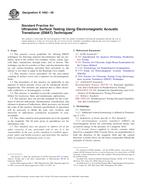Potřebujeme váš souhlas k využití jednotlivých dat, aby se vám mimo jiné mohly ukazovat informace týkající se vašich zájmů. Souhlas udělíte kliknutím na tlačítko „OK“.
ASTM E1962-09
Standard Practice for Ultrasonic Surface Testing Using Electromagnetic Acoustic Transducer (EMAT) Techniques
Automaticky přeložený název:
Standardní praxe pro ultrazvukové zkušební povrch pomocí Elektromagnetická Akustické měniče ( EMAT ) techniky
NORMA vydána dne 1.6.2009
Informace o normě:
Označení normy: ASTM E1962-09
Poznámka: NEPLATNÁ
Datum vydání normy: 1.6.2009
Kód zboží: NS-43754
Počet stran: 8
Přibližná hmotnost: 24 g (0.05 liber)
Země: Americká technická norma
Kategorie: Technické normy ASTM
Anotace textu normy ASTM E1962-09 :
Keywords:
electromagnetic acoustic transducer, EMAT, flaw detection, NDT of welds, nondestructive testing, Rayleigh, surface waves, ultrasonic inspection, EMAT (electromagnetic acoustic transducer), Flaw detection, Nondestructive evaluation (NDE), Rayleigh waves, Ultrasonic testing, ICS Number Code 77.040.20 (Non-destructive testing of metals)
Doplňující informace
| Significance and Use | ||||||||||||||||
|
EMAT techniques show benefits and advantages over conventional piezoelectric ultrasonic techniques in special applications where flexibility in the type of wave mode generation is desired. EMATs are highly efficient in the generation of surface waves. Since EMATs are highly efficient in the generation of surface waves, and since acoustic techniques utilizing surface waves are proven effective for detecting surface and near-surface discontinuities, they should be considered for any applications where conventional penetrant testing and magnetic particle NDT techniques are effective but undesirable. Since EMAT techniques are non-contacting, they should be considered for ultrasonic testing where applications involve automation, high-speed inspections, moving objects, applications in remote or hazardous locations, applications to objects at elevated temperatures, or objects with rough surfaces. The purpose of this practice is to promote the EMAT technique of the ultrasonic method as a viable alternative to conventional PT and MPT methods for detecting the presence of surface and near-surface material discontinuities. The use of EMATs and the selection of appropriate operating parameters presuppose a knowledge of the geometry of the component; the probable location, size, orientation, and reflectivity of the expected flaws; the allowable range of EMAT lift-off; and the laws of physics governing the propagation of ultrasonic waves. This procedure pertains to a specific EMAT surface inspection application. |
||||||||||||||||
| 1. Scope | ||||||||||||||||
|
1.1 This practice covers guidelines for utilizing EMAT techniques for detecting material discontinuities that are primarily open to the surface (for example, cracks, seams, laps, cold shuts, laminations, through leaks, lack of fusion). This technique can also be sensitive to flaws and discontinuities that are not surface-breaking, provided their proximity to the surface is less than or equal to the Rayleigh wave length. 1.2 This practice covers procedures for the non-contact coupling of surface waves into a material via electromagnetic fields. 1.3 The procedures of this practice are applicable to any material in which acoustic waves can be introduced electromagnetically. This includes any material that is either electrically conductive or ferromagnetic, or both. 1.4 This practice is intended to provide examination capabilities for in-process, final, and maintenance applications. 1.5 This practice does not provide standards for the evaluation of derived indications. Interpretation, classification, and ultimate evaluation of indications, albeit necessary, are beyond the scope of this practice. Separate specifications or agreement will be necessary to define the type, size, location, and direction of indications considered acceptable or non-acceptable. 1.6 The values stated in inch-pound units are to be regarded as the standards. The SI units given in parentheses are for information only. 1.7 This standard does not purport to address all of the safety concerns, if any, associated with its use. It is the responsibility of the user of this standard to establish appropriate safety and health practices and determine the applicability of regulatory limitations prior to use. |
||||||||||||||||
| 2. Referenced Documents | ||||||||||||||||
|




 Cookies
Cookies
